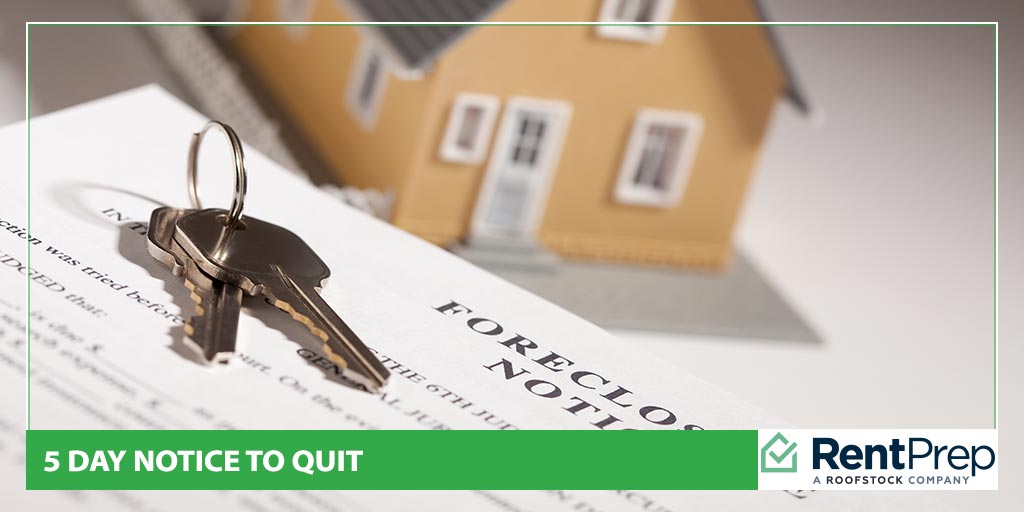
No matter how much care you put into finding a great tenant or ensuring that your rental agreement covers all the necessary details, there will come a time when you need to deal with eviction forms.
Even if you don’t ultimately end up in a court proceeding through a full-blown eviction hearing, there are going to be instances when you need to use an eviction form to get a tenant to take action.
One form that you will definitely need as a landlord is the 5-day notice to quit. This 5-day notice form can serve as a serious reminder to tenants that there are legal obligations between you both that must be followed.
But you can only enforce those legal paths if you follow the correct rules, too! That means that you need to be able to create and serve a perfect 5-day notice.
Don’t worry if you don’t have a solid 5-day notice in your arsenal yet; our free 5-day eviction notice has you covered!
A Table Of Contents For 5-Day Letter Eviction Rules
- What Is A 5-Day Notice Form?
- How To Deliver A 5-Day Letter Eviction
- Reminder: State Law Differences
- How To Use This Free 5-Day Eviction Notice
What Is A 5-Day Notice Form?
Let’s start with the most important basics about this 5-day eviction notice form.
A 5-day notice to quit form is a document that can be used to notify tenants that they need to remedy a violation of their lease agreement or leave the property. Once received, tenants have five days to respond in some way. If they do not take action, they can be evicted through the court system.
You will want to write this type of eviction letter accurately and within the terms of all local laws. If you do not file it properly, you may need to try again, thus adding to how long it will take to get a bad tenant off your property and out of your life.
5-Day Notice To Quit: Violation Reasons
There are a lot of different violations the 5-day notice to quit form might need to be used.
The number one reason landlords find themselves reaching for this document is when tenants are late paying their rent. If a tenant has not paid their rent yet and any lease- or state-mandated grace periods have passed, this notice can be sent immediately.
The only states that require grace periods at this time are:
- Arkansas – 5 days
- Connecticut – 9 days
- Maine – 15 days
- Massachusetts – 30 days
- New Jersey – 5 days for protected classes
- North Carolina – 5 days
- Oregon – 4 days
- Tennessee – 5 days
- Texas – 1 day
But nonpayment of rent is not the only reason that a 5-day notice form can be used.
In fact, this form can be used for most serious lease violations. Any violation that needs to be remedied by the tenant or else can be considered as a starting point for sending this lease. Some of the most common violations include:
- Parking in the wrong area
- Causing damage to the property intentionally
- Breaking the pet clause
- Housing more people than allowed
- Doing anything that is expressly prohibited in the lease
It can be a bit overwhelming for landlords to think about all of the possible reasons to use this form.
Instead of thinking about all of the possibilities, think about it this way: This single form can be adjusted to work for a large number of situations. That means once you have this form set up properly, you’ll lighten your workload if any of these situations come up in the future!
Remedy Or Quit?
New landlords are often confused about the names of eviction notices. Sometimes, this form is known as a 5-day pay or quit; at other times, it’s just called a 5-day notice to quit.
In most cases, the forms are the same thing with one big difference.
Certain situations can be remedied by the tenant. If, for example, they haven’t paid their rent yet or they won’t mow their lawn, this can be remedied. In these cases, they have a chance to fix the situation before they will need to vacate.
In other situations, there is no chance they can stay. These are more serious cases – such as when a tenant causes structural damage to the property or they were caught doing something illegal on the property. In these cases, there is no negotiation. The tenant must leave unless they want to go to court to fight your decision.
How To Deliver A 5-Day Letter Eviction
When it’s time to send out a 5-day notice to pay or quit, you might be unsure about when to send it out and what to do. Let’s break down the steps.
Step 1: Deliver Quickly
No matter how you feel about your tenants, this notice should be sent out as soon as possible to ensure that your communication is quick, clear, and efficient.
If the tenant is supposed to pay rent by the 1st but they have not paid by the 3rd, you need to send this notice. Some states require a grace period. If this applies to you, send it as soon as possible. The sooner you sent the notice, the better.
Step 2: Make Sure They Receive It
It’s essential that the tenant receives the notice directly, and it’s even better if you have proof that they received it. We recommend using certified mail to ensure proper delivery, but most states permit you to hand deliver the notice to the tenants as well as post it to their property in a clearly visible location.
Step 3: Wait
Once the notice is received, the tenant has 5 business days to remedy the situation or otherwise respond to you. There’s nothing for you to do at this point but wait. If you want, you can begin gathering any relevant evidence that you would need for an eviction hearing.
Step 4: Move To Court
If the tenant does not remedy the violation or move out within the allotted period, it’s time to head to your local courthouse. You need to start the eviction filing as soon as possible to regain control of your property.
Reminder: State Law Differences
It can be frustrating for landlords, but the simple truth is that every state has its own set of landlord-tenant laws. Because these laws are not mandated on a national level, the states must decide what is appropriate and what is not.
When it comes to 5-day eviction notice forms, this means that there may be some differences in how long you need to wait before you send the form, how long the tenant has to reply to the form, and what you need to include in the form.
Though our form can be used in a wide range of states, you should always confirm that there are no local or state laws that affect how it can be used before you put it into action.
How To Use This Free 5-Day Eviction Notice
It’s time to talk about how to actually use our 5-day notice to pay rent template. Take a look at what we’ve included in the template:
| 5-Day Notice to Quit |
While you can easily make adjustments to this template to fit your business needs, you should first understand what has been included and why. We will start with that information.
Facts & Identifying Information
Important rental documents should always begin by covering all identifying information. Having these practical facts listed on each document helps to keep all of the legalese clear and accurate.
For this eviction notice, make sure to include the following:
- Date
- Property address
- Tenant name
- Name of landlord and tenant
- When the legal agreement went into effect
Identify The Breach & Terms of Remedy
Once you’ve filled out all of the identifying information, you should then clarify what violation has occurred and what actions need to be taken by the tenant.
If they didn’t pay rent on time, you should write nonpayment of rent. To avoid moving, write that the tenant needs to pay all late rent within 5 days. If the tenant committed another violation, include it in this section. If possible, include the relevant clause name or number from the original rental agreement.
Clearly stating the terms of potential remediation is important. If the tenant wants to stay at the property, they will act swiftly to fix the problem or contact you with their plan to fix the problem. Giving them this opportunity can improve your relationship with the tenant and lead to a more successful rental relationship in the long run.
What Will Happen
Finally, it is your duty as the landlord to let the tenant know what will happen if they do not take action or respond to your notice in the appropriate amount of time.
In this case, you should let them know that not responding will lead to an eviction filing and hearing with the court. Most tenants will not want to go that route, so don’t be surprised if you manage to come to a resolution without getting the courts involved!
The Complications Of Eviction Notices
We understand how complicated it can be to understand all of the different eviction notices and processes that you may need to deal with when working as a landlord, but remember that getting a grasp on the 5-day notice to quit form can help in a wide range of situations.
Landlords can benefit from having a high-quality supply of notices, letters, forms, and contracts that they can put to use while managing their rental properties. If you need to start building your form vault from scratch, these bundles might be able to help you get organized!


